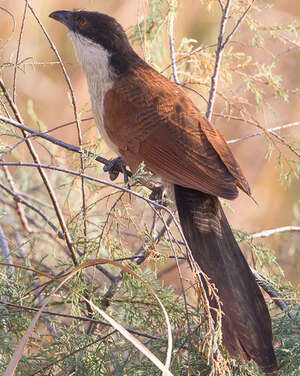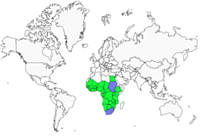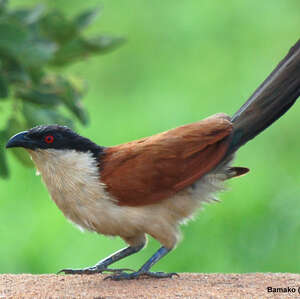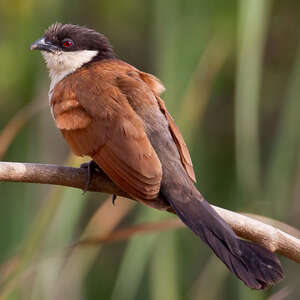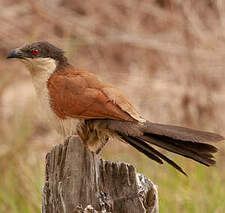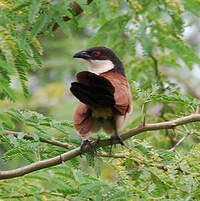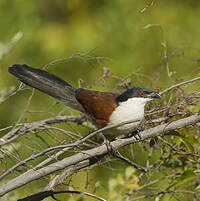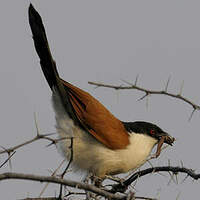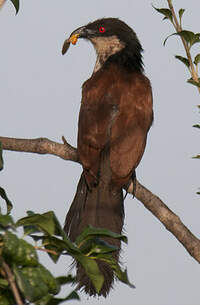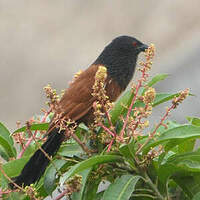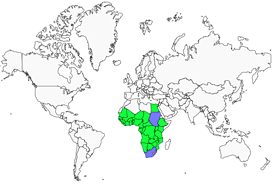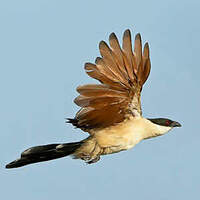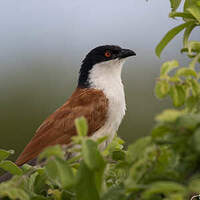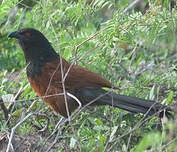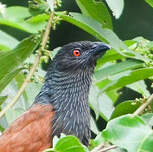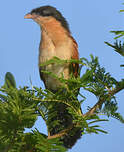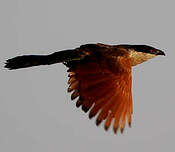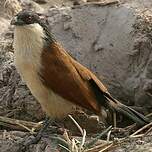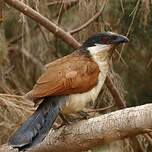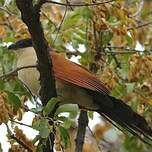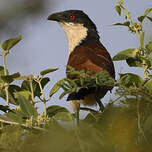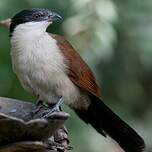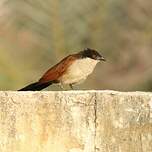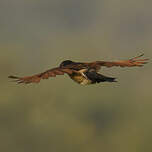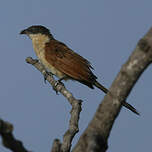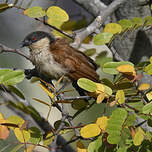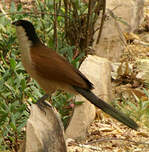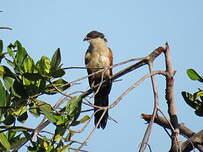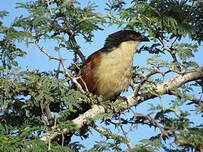Senegal Coucal
Centropus senegalensis - Coucal du Sénégal
Identification
A funny large cuckoo, the Senegal Coucal, 36 to 42 cm, a curved black beak, red ocular circles surround the black pupil and give it almost a stern look; the head and neck are black with shiny reflections and the separation from the brown-russet mantle is quite distinct, this brown-russet shade slightly tinting the tip of the remiges. The tail is long and black. The bird has a creamy white color on the throat, chest and belly, sometimes shaded with reddish reflections on the sides of the belly and abdomen; when the bird agrees, it will show whitish undertail feathers, horizontally striped with fine grey striae. The legs have black tarses extended by long claws. The female is barely bigger than the male, in fact there is no dimorphism; the young ones have a uniform striped horizontally with dark brown lines on the back, mantle, wings, remiges and tail. The cap is also striped and very thin white streaks can be distinguished on this as well as on the neck, these fine stripes will disappear when the bird grows up. A black-bellied form, called epomidis can be found on the Nigerian coast and in Ghana without being qualified as a separate race or subspecies, and still related to Centropus senegalensis.
Subspecific information 3 subspecies
- Centropus senegalensis senegalensis (Senegal and Gambia to Eritrea, south to nw Angola, sc DRCongo and Uganda)
- Centropus senegalensis aegyptius (s Egypt)
- Centropus senegalensis flecki (e Angola to ne Namibia and sw Tanzania, south to Malawi and Zimbabwe)
Foreign names
- Coucal du Sénégal,
- Cucal senegalés,
- pássaro-governo,
- Spornkuckuck,
- szenegáli bozótkakukk,
- Senegalese Spoorkoekoek,
- Cuculo fagiano del Senegal,
- senegalsporrgök,
- Senegalsporegjøk,
- ostrohár hrdzavý,
- kukačka senegalská,
- Sporegøg,
- afrikankukaali,
- Senegalvleiloerie,
- cucal del Senegal,
- Sporagaukur,
- kukal senegalski,
- Senegālas koukals,
- senegalski kukal,
- Сенегальская шпорцевая кукушка,
- セネガルバンケン,
- 塞内加尔鸦鹃,
- 塞內加爾鴉鵑,
Voice song and cries
It is thought that the Senegal Coucal honks, a muffled and very short sound, spaced at first and increasing in speed coo-coo-coowooo. The song or call leaves a strange feeling which doesn't allow for the bird to be located if it was not spotted beforehand. It also emits k-t-k-t-k-t-k-t-k.
Habitat
Often present in undergrowth, scrubland, near water courses, sugarcane plantations, palm groves, or even in parks or gardens, the Senegal Coucal can tolerate dry and semi-desert environments. In the south-west of Tanzania, it is found at the edge of very sparse forests, whereas Centropus superciliosus, the White-browed Coucal, will reside in denser forests and close to rivers.
Behaviour character trait
Dietfeeding habits
Completely carnivorous, everything is good for its diet: insects, termites, snails, small rodents, it will vary its menu with other birds and will not hesitate to raid nests to eat nestlings or eggs. It is often observed jumping on the ground in search of food. Our Senegal Coucal is clever, we have already seen it at the edge of burned areas waiting for prey fleeing the fire!
Reproduction nesting
The Senegal Coucal is monogamous and generally reproduces during the rainy season, which will allow it to find the grass and vegetable fibers it needs to build its nest, from March to August in Egypt, from May to October in Senegal, or from July to November in Gambia.
It is often seen that the couples coupled before or just after heavy rains. This member of the Cuculidae family does not parasitise other species, the female builds a rough nest made of grass and twigs, which she lines with green leaves, often in thick copses or bushes, sometimes in trees. 2 to 5 eggs will be incubated for 18 to 19 days. The chicks will be fed by their parents for about twenty days before they can leave the nest.Geographic range
Senegal Coucal (Ssp senegalensis) is present from the center of Africa, from Senegal and Gambia, to Somalia, Eritrea, passing through the east of Uganda, west Kenya, Angola and the south and the center of Zaire. The ssp flecki, with a crown of blueish reflections, can be found in the east of Angola, in Namibia, Botswana, Malawi, Zambia, Zimbabwe and southeastern Tanzania. Finally, ssp aegyptus, bigger and with a brown-reddish color of the coat and the back paler, is curiously separated from its cousins and is visible in Egypt, particularly along the Nile.
Threats - protection
IUCN conservation status
concern
in the Wild
threatened
evaluated
The LC, common throughout its distribution range, Senegal Coucal (Centropus senegalensis) is content with human closeness; the aegyptus subspecies is extending in Egypt and is now found around Cairo and along the entire Nile Valley.
Sources of information
- IOC World Bird List (v14.1), Gill, F and D Donsker (Eds). 2024-04-18.
- Birds of Kenya and Northern Tanzania, Dale A Zimmerman, Donald A Turner, David J Pearson
- Birds of Western Africa, Nick Borrow and Ron Demey
- Guide encyclopédique des oiseaux du Paléarctique occidental, Mark Beaman, Steve Madge
- Vol. 4 - Handbook of the Birds of the World, Josep del Hoyo-Andrew Elliott-Jordi Sargatal
- Wikipédia, Wikipedia, The Free Encyclopedia
- Biodiversity explorer The web of life in Southern Africa,
Other sources of interest
 Specification sheet created on
29/07/2023 by Anne et Gabriel Leboff
Specification sheet created on
29/07/2023 by Anne et Gabriel LeboffTranslation by AI Oiseaux.net
published: 27-05-2013 - Updated: 13-06-2013
© 1996-2024 Oiseaux.net
- Accipitriformes
- Aegotheliformes
- Anseriformes
- Apodiformes
- Apterygiformes
- Bucerotiformes
- Caprimulgiformes
- Cariamiformes
- Casuariiformes
- Charadriiformes
- Ciconiiformes
- Coliiformes
- Columbiformes
- Coraciiformes
- Cuculiformes
- Eurypygiformes
- Falconiformes
- Galliformes
- Gaviiformes
- Gruiformes
- Leptosomiformes
- Mesitornithiformes
- Musophagiformes
- Nyctibiiformes
- Opisthocomiformes
- Otidiformes
- Passeriformes
- Pelecaniformes
- Phaethontiformes
- Phoenicopteriformes
- Piciformes
- Podargiformes
- Podicipediformes
- Procellariiformes
- Psittaciformes
- Pterocliformes
- Rheiformes
- Sphenisciformes
- Steatornithiformes
- Strigiformes
- Struthioniformes
- Suliformes
- Tinamiformes
- Trogoniformes

